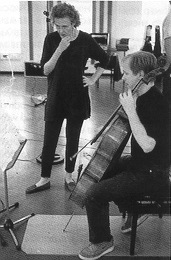Petal 001

Kaija Saariaho, works for cello:
Petals, Près, Spins and Spells
Anssi Karttunen, cello
Petals (1988), for cello and live electronics
Petals (1988) for solo cello was written fast in only a few days, but evidently after a long unconscious preparation. The material comes directly from Nymphea for string quartet and electronics. The name of the piece is derived from this relationship.
The opposite elements here are fragile, coloristic passages which give birth to more energetic events with clear rhythmic and melodic character. These more sharply focused figures pass through different transformations, and finally merge back to less dynamic but not less intensive filigration. In bringing together these very opposite modes of expressions I aimed to force the interpreter to stretch his sensibility.
Petals was inspired by the playing of Anssi Karttunen and is dedicated to him. The first performance was at the Musica Nova festival in Bremen the 19th of May 1988.
Près (1991), for cello and live electronics
Près for solo cello and electronics emerged at the same time as Amers, a concerto for cello and chamber orchestra. The musical material in the two works is to a large extent the same. Given the very different means of implementing the material, however, the only identical elements are certain parts for the solo instrument and few of the electronic sound material. In terms of form and dramatic structure the pieces are strikingly different. Both were produced at IRCAM, and the electronic component is very important in each case. In Près the electronics continue and expand in many different directions the musical gestures of the solo instrument.
Près is in three movements. The first movement concentrates on a rather linear texture, in which the cello part is in places fused with the synthetic sounds. This material is based on recordings that I made with Anssi Karttunen and have subsequently either analyzed and used as the starting point for the work's harmony and sound synthesis, or transformed in different ways.
The synthetic element is realized using resonant filters that also operate in real time in the succeeding movements, where the cello sound is modified on a music workstation developed at IRCAM.
As a whole the electronic element consists of synthetic sounds, modified cello sounds stored in the computer, and real-time sound processing. This latter element has made use of resonating filters and different types of delay, space, filtering, and transposing techniques. The programming work was realized by Xavier Chabot and Jean-Baptiste Barrière at IRCAM.
The name of the piece links it to its sister-work (Amers - a nautical term for leading marks or landmarks), as well as Paul Gauguin's painting By the Sea, and hence to the experience of the sea itself and waves, their different rhythms and sounds, stormy weather and calms. In other words: material, wave shapes, rhythmic figures, timbres. The charging up of the music and the ultimate release of that charge.
Près is dedicated to Anssi Karttunen, whose collaboration on the work led to its completion and who gave the first performance in Strasbourg on November 11th 1992.
Spins and Spells (1997), for cello solo
The title of this piece refers to the two gestures that are the basis of the piece: on one hand the motives I call ”Spins”, turning on themselves or going through transformations and, on the other hand, timeless moments, centered on colors and sound textures.
The whole piece develops around or between these two gestures. I have chosen to tune the cello in an unusual way in order to personalize the harmonic language: the fifths are here replaced by structures that favor major sixths and minor thirds.
Marked by this scordatura, the sonority of Spins and Spells reminds me of the music and instrumental colors of another time, well before the times of the cello that we know today, albeit seen through and transformed by my own universe.
Kaija Saariaho
